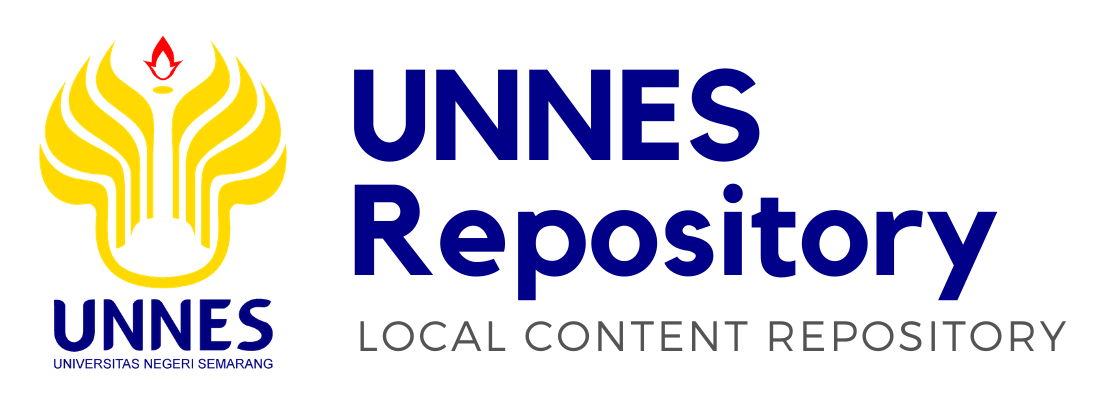NOUN PHRASE CONSTRUCTIONS FOUND IN STUDENTS’ TRANSLATION FROM INDONESIAN INTO ENGLISH TEXT BY ENGLISH DEPARTMENT STUDENT OF SEMARANG STATE UNIVERSITY ACADEMIC YEAR 2009/2010
Dwi Arni Siti Margiyanti, 2201406545 (2011) NOUN PHRASE CONSTRUCTIONS FOUND IN STUDENTS’ TRANSLATION FROM INDONESIAN INTO ENGLISH TEXT BY ENGLISH DEPARTMENT STUDENT OF SEMARANG STATE UNIVERSITY ACADEMIC YEAR 2009/2010. Under Graduates thesis, Universitas Negeri Semarang (UNNES).
Preview |
PDF (NOUN PHRASE CONSTRUCTIONS FOUND IN STUDENTS’ TRANSLATION FROM INDONESIAN INTO ENGLISH TEXT BY ENGLISH DEPARTMENT STUDENT OF SEMARANG STATE UNIVERSITY ACADEMIC YEAR 2009/2010)
Download (225kB) | Preview |
Abstract
Margiyanti, Dwi Arni Siti. 2010. Noun Phrases Construction Found in Students’ Translation from Indonesian into English Text by English Department Student of Semarang State University Academic Year 2009/2010. The English Department, the Faculty of Languages and Arts, Semarang State University. First advisor: Drs. Yan Mujianto, M.Hum. Second advisor: Drs. L. Elyas Nugraha, M.A. One of the goals of translation is to get the message or main ideas conveyed in another language. Besides the meaning, the form of language is important since it is sometimes different each other. The form in this study is the Noun Phrase Construction. The objectives of this study are to describe the types of Noun Phrase Construction in students translation from Indonesian into English texts and find out the tendencies and problems occur in the students translation of Indonesian into English noun phrases. As a source of data, the writer that utilized the result of English Department students’ translation. There are thirty texts. Each student gets different text. All of noun phrases used by the students are listed and then analyzed. This research is designed as a qualitative research. The results of the analysis shows that there are three kinds of noun phrase constructions found in the students’ translation, they are; Pre- Modifier + Head, Head + Post Modifier, and Pre- Modifier + Head + Post- Modifier. The use of each pattern in the students’ translation can be seen by the percentage on the findings. The percentage of Pre-modifier + Head pattern appearance is 73.6%, the second pattern Head + Post-Modifier is 3.9%, and the third pattern Pre- Modifier + Head + Post- Modifier is 22.5%. In conducting the analysis by comparing the Indonesian and English noun phrases, there are three differences found between them. The first is the difference of the noun phrase pattern formed by the students when they translated Indonesian into English text. The second and the third are the changing of wording and part of speech between Indonesian and English in a noun phrases. Some mistakes are made by the students in translating noun phrase. Some difficulties especially faced when they had to translate the source noun phrase, in this case Indonesian noun phrases, into the target noun phrase that was English noun phrase. Some of the problems found based on the data analysis were in the term of: (1) article, (2) equivalent word, (3) adding and omitting ‘s’, (4) adjectives order.
| Item Type: | Thesis (Under Graduates) |
|---|---|
| Subjects: | P Language and Literature > PE English |
| Fakultas: | Fakultas Bahasa dan Seni > Pendidikan Bahasa Inggris (S1) |
| Depositing User: | Users 3314 not found. |
| Date Deposited: | 20 Nov 2011 12:02 |
| Last Modified: | 20 Nov 2011 12:02 |
| URI: | http://lib.unnes.ac.id/id/eprint/8490 |
Actions (login required)
 |
View Item |
